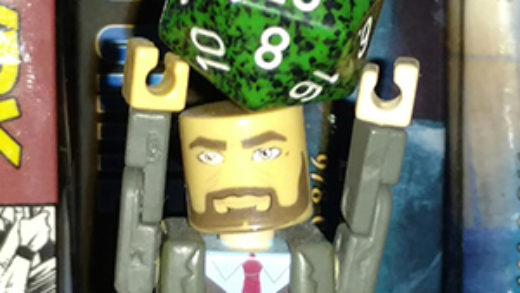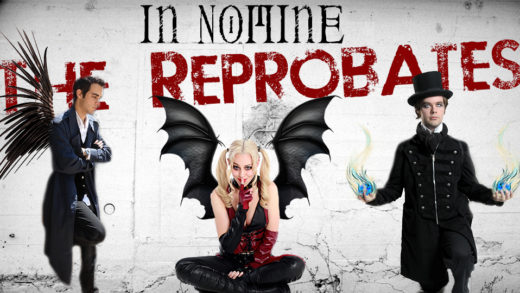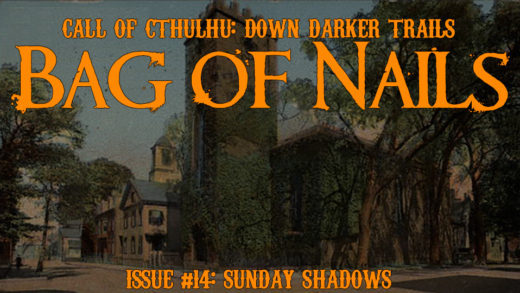A good horror game requires ambience, pacing, and, most importantly, for the players and their characters to be afraid. This can be a difficult scenario to conjure in any genre, but high fantasy presents numerous challenges. When characters can detect evil, banish the undead, and harness fireballs, how does a GM introduce fear without taking away player agency or character abilities? Here are some of the tips and tricks I’ve found over the years that have worked best with my groups. Many of these ideas are not unique and apply to most horror games, but I’ve specifically written them with the more tactical/powerful fantasy games in mind (Pathfinder and Dungeons & Dragons).
Minimize Table Chatter
For a horror game to be effective, players will need to stay in character and focused on the game. Ambient music, props, and pictures go a long way to making the players think more about the game. Descriptiveness is also key, but it should be rehearsed and brief; a dry or long reading and players may start zoning out. Boredom is far more antithetical to horror than humor is. When being descriptive, utilize words or ideas that are almost inherently creepy; my lexicon includes words like: bile, drool, drips, murky, shadowy, etc. Telling players their characters are in a 10 foot by 10 foot room and detailing every brick is not creepy. Informing players that they’re in cramped quarters where the walls are dripping with ichor and their noses are assaulted by the smell of sulfur and vomit is far more effective.
Build a Background
Even if the players never discover the reason for the horrors they’re facing, the GM should know the whens and whys of how the place came to be. A ghost is more effective when it has a tragic or bloody past and unusual monsters should come from someplace–be it another plane, an insane wizard, or a ritual gone horribly wrong (or right). The backstory should permeate through the adventure and provide clues, should players wish to follow them, but should not be heavy handed. Railroading players or making them feel like they should be following a script reduces their agency and that can increase frustration and boredom.
Complicated Maps
One of the classic staples of high fantasy gaming is players getting out their graph paper and mapping as they explore. If this is the style of your game, use it to your advantage. Randomly shifting hallways and teleport trap like features are a fair start, but some players may not feel threatened or creeped out. I find it more fun to use player expectations against them. Depending on the type of horror they’re facing, I may make rooms or hallways feel longer or larger than they actually are, or keep a large room so cramped with items that it appears smaller than it is. Architecture/maps may be stable but have a “who designed this” approach, where nothing seems quite orderly. A personal favorite of mine, when dealing with mappers, is to create duplicate spaces within the map, so it seems like the adventurers had passed through the space already.
Slow Burn / Low Combat
Heavy combat and the chance of a character dying may provide some tension, the overall action can hinder the influx of horror. While there may be the occasional action beats, if there is combat it should be kept quick and with the type of horror either easily dying (to be replaced by more), appear dead (to return later) or escaping (to be re-hunted). A horror game should be a slow burn, with tension and unease building throughout the adventure and some sporadic releases with jump-scares or the aforementioned fast combat.
Dealing with Magic
This is an issue that many horror games don’t have to deal with. When player characters have the ability to detect evil, ward off evil, or hurl devastation from their fingertips, it can feel “cheap” if the GM makes their powers go away or make the horror invincible. Instead, plan ahead with the characters powers in mind so their very spells would either work against them or feel useless. When detecting evil, have it permeate every space, making it impossible to pinpoint. Allow warding of evil or undead to work against creatures, but not the walls themselves, the horror should fight back in unexpected ways. Place the characters in unstable environments so that destructive magic risks harming them more than the nightmares that haunt them. Yes, some players may opt to take the “nuke it from orbit” approach, but remind them that, in doing so, they lose any knowledge, treasure, or goods inside and it may only allow the evil to spread in an unexpected way.
Psionic/Psychics and Racial Abilities
Like magic, psionics and racial abilities may seem like an advantage against horror; but knowing how the abilities work also means knowing how to make them work against the players. The ability for some races to see in the dark should make darkness seem no less pervasive or quarters less cramped; sharp-eyed darkvision or infrared may see the shadows creeping and gore on the terrain that goes unnoticed by other characters. Using mind reading or attempted mind control may allow the horrors easy access to the psychic or may overwhelm their senses with how unnatural the creepiness may be. While these characters may not literally fumble around in the dark, they should be no more comfortable in the metaphorical darkness.
NPCs
If the players don’t realize that the adventure or game they’re in is a horror game, then they may be more apt to include new NPCs into their party. If the players know they’re about to be embroiled in a saturation of evil and monstrosity, it may be hard not to meta-game and not include any new NPCs. These new characters may be crucial for providing initial fodder for the horrors or to rouse suspicion in the players. If running a campaign and know you’ll be introducing a horror adventure within the overall scope and will need NPCs to mysteriously die or vanish on the players, consider introducing the characters in a separate, earlier, adventure. Bonding with an NPC makes their gruesome or mysterious demise far more palpable.
Everyone Is Suspect
Paranoia and horror complement each other well. While some horror scenarios might place players against the existential or physical monsters consider an adventure dealing beings that replicate, infect, or possess characters. Pitting player against player can amp up the tension greatly, but be careful to ensure player characters do not kill other player characters, as that sort of tension often harms the overall sense of horror.
Avoid Hordes of Monsters
While some horror games work on the idea that the player characters are hopelessly outnumbered, this often doesn’t hold up as well as a horror situation in high fantasy gaming. It may create a tension of tactics or resources, but rarely of lurking dread. If the desire is to invoke a sense of overwhelming fright, consider using smaller, creepy-crawlies instead of outright monsters. Walls teeming with spiders and centipedes, a nest of roaches crawling from the floorboard, a room blackened by a mass of flies. These pose no obvious threats to the player characters to put the players in to a mode of combat, but still can invoke the idea that they’re dealing with great odds.



Recent Comments